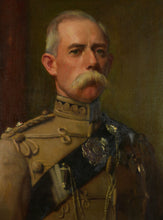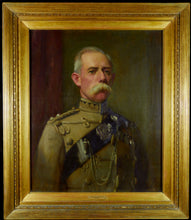Portrait of a ‘Piffer’ - Colonel Robert Ramsay Napier Sturt, C.B. 2nd Punjab Infantry
Adding product to your cart
Overall: 88cm (34.5in) x 76cm (30in)
Oil on canvas. In original giltwood glazed frame.
The subject is depicted in full dress uniform of the 2nd Punjab Infantry of the period 1861-1903, comprising the ‘Piffer’ drab coat with regimentally specific black facings, drab lace and shoulder rank badges of a lieutenant-colonel - the sitter having been awarded a brevet promotion on 20 May 1898. He sitter also wears Frontier Force Infantry shoulder belt with silver regimental badge, chains and whistle, together with three campaign medals representing Sturt’s Frontier service (Afghanistan Medal 1878-80, 1 clasp, Peiwar Kotal; India General Service Medal 1854-95, 2 clasps, Samana 1891, Waziristan 1894-5; India General Service Medal 1895-1902, 3 clasps, Punjab Frontier 1897-98, Samana 1897, Tirah 1897-98). Canvas size: 71cm x 58cm (28in x 22.5in) . Signed and dated 'Frederick Beaumont / Sept 99’.
Robert Ramsay Napier Sturt (1852-1907) was the scion of an old Dorset family, but as the younger son of a younger son and a mother widowed at an early age, he followed in immediate forebears footsteps and looked to the East to make a career. He was born in India at Calcutta on 13 May 1852, the second son of Colonel W. M. N. Sturt, H.E.I.C.S., who died at Shahjahanpur in 1855, and the nephew of the Australian explorer Captain Charles Napier Sturt (1795-1869). His grandfather was a judge also in the East India Company Service, and his great grandfather, Charles Sturt (1764-1812) of Brownsea Castle, was an indifferent M.P. for Dorset, a notorious rake and friend of the Prince Regent.
Sturt was educated at Repton and resided briefly in west London with his mother and five sisters, toiling as a ‘writer in a Government office’, before returning to India with a commission in the Bengal Staff Corps in 1872. The combination of a light purse, good family connections, a taste for Spartan living and the promise of adventure secured him an appointment in the Punjab Frontier Force, or ‘Piffers’, on the North West Frontier where something akin to active service was a near permanent state of affairs – a fact jealously recognized by the young Winston Churchill whose own British cavalry regiment languished in southern India, being deemed too impractical and too expensive to risk in frontier operations.
With only seven British officers in a Piffer battalion, men such as Sturt were compelled to quickly win the confidence of British and Indian comrades. Failure to do so meant expulsion. The Piffers regarded themselves as a special entity, separate from the rest of the British Indian Army being outside the authority of the armies of the three presidencies. Sniping, night marches and sentry duties with real purpose served to engender an esprit de corps born of the special skills necessary to deal with resourceful tribal enemies ever ready, as Kipling noted, to finish off the wounded and mutilate the dead.
Sturt’s first recorded active service was in opening stages of the Second Afghan War at the capture of the Peiwar Kotal Pass from forces under Karim Khan. He took part in the Mahsood Wuzeeree Expedition of May 1881, and served in command of a wing of his regiment during the operations the Miranzi Expedition in early 1891, being favourably mentioned in despatches (London Gazette 15.9.1891). In 1890 he was with the Zhob Valley Field Force.
Like many of the imperial class of his day, Sturt left the business of marriage and the begetting of heirs until middle age. In 1894 he returned to England on furlough and married at Wimborne, Dorset, Ethel Harriette Turner, youngest daughter of Major Spence Turner, late of the Bengal Army. In so doing Sturt was re-affirming a connection with the county where the Sturts were still people of importance. A few miles north west of Wimborne is the picturesque village of Witchampton which serves as the backdrop to Crichel House, the classical revival seat remodelled by Sturt’s great great grandfather, Humphrey Sturt (1724-1786), and in the 1890s occupied by Sturt’s distant cousin Humphrey Napier Sturt, 2nd Baron Alington (1859-1919). Also living at Witchampton at this time was the artist Frederick Beaumont, then engaged in a series of portraits of members of the Pitt-Rivers family.
Returning to India with his bride, Sturt was soon on active service again, this time commanding his regiment in the Waziristan Operations of October 1894 to March 1895 under Sir William Lockhart. He next served with the Kohat-Kurram Field Force in the campaign under Lockhart of 1897-98, again in command of the 2nd Punjab Infantry, being present in the engagement at the Ublan Pass on 27th August 1897, for which mentioned in despatches by Brigadier-General Yeatman-Briggs for ‘the very determined manner’ in which he led his regiment into the attack (London Gazette 21.12.1897). He was further present in the operations on the Samana in August and September 1897, including the defence of the Samana posts and the relief of the Gulistan fort and with the Tirah Expeditionary Force, including the march down the Bara Valley (mentioned in despatches (London Gazette 5.4.1898), brevet of Lt.-Colonel, medal with three clasps).
Beaumont’s portrait of Sturt indicates he was once more in England in 1899. Our last glimpse of him comes in 1902 when his career service on the North West Frontier was officially acknowledged with the honour of Companion of the Bath on 26 June 1902. One wonders if Sturt’s surname registered with Edward VII as the lean, stiff-backed Colonel approached the dias to receive his hard earned gong, as the same as that of Lord Alington, the onetime seducer of the favourite royal mistress Alice Keppel – the answer is probably not.
The career path of Fredrick Beaumont (1861-1950) was not always as clear as he may have wished. Born in Yorkshire and educated at the Camden House School, Brighton, he showed early talent for drawing but initially worked in a fancy goods warehouse in the seaside town. However a chance meeting with the elderly portraitist E. Goodwyn Lewis (whose sitters had included Charles Dickens no less) persuaded him to change careers. Beaumont studied at the Royal Academy Schools from 1882 to 1888 (winning a silver medal in Life Study) and at the Académie Julian in Paris. He then spent time in France, Italy and Spain studying the Old Masters.
Beaumont married well. His wife was Clare Adderley, daughter of Sir Augustus Adderley, K.C.M.G., of the Bahamas. They settled near Wimborne, Dorset, where he was much sort after as a portrait painter and enjoyed the patronage of the eminent archaeologist and collector Lieutenant-General Augustus Pitt-Rivers. Beaumont also maintained a studio in London at his father-in-law’s house at 4 Douro Place, Kensington, where many of his portraits were executed. Conveniently, Mrs Sturt also had an apartment nearby in Avonmore Mansions.
Beaumont was later associated with the Cornish artists colony at St. Ives both before and during the First World War. In 1922 he visited America with his contemporary at the R.A. Schools in the 1880s, Arthur Nowell, R.I., R.P (1862-1940) who had a seasonal studio in the Singer Skyscraper in New York. Beaumont’s latter years were spent in Kensington and in 1947 he was the subject of a profile in The Artist.
A list of Beaumont’s works in public collections: Williamson Art Gallery, Birkenhead, Merseyside (Arthur W. Wilmer, Mayor of Birkenhead); National Museums and Galleries of Wales (Welsh singer Madame Leila Megane (1891-1960), as Orphée); Walker Art Gallery, Liverpool (Liverpool businessman & shipowner Sir Alfred Lewis Jones (1845-1909), 1906); Royal Society of Medicine (Sir Harry Jones, Surgeon-Dentist to George V); Pitt-Rivers Museum, University of Oxford (Lieutenant-General Augusts Pitt Rivers, the ‘father of scientific archaeology’, High Sheriff of Dorset, 1884); Whitworth Art Gallery, University of Manchester (Mr Horsfall, 1914); Salisbury and South Wiltshire Museum (Augustus Henry Lane Fox Pitt Rivers, 1897).
References:
Wright, C., Gordon, C.M., & Peskett Smith, M. (eds.) (2006) An Index of British and Irish Paintings in Public Collections, Paul Mellon Centre for Studies in British Art, Yale University Press.
The Artist, 1947, F.S. Beaumont by Raymond H. Sawkins, p.517, Volumes 33-37.
Beaumont & the Pitt-Rivers family: Rethinking Pitt-Rivers
Dix, Noonan & Webb, Auction Catalogue of Orders, Decorations and Medals: 4th April 2001, Lot 267.
Fox-Davies, A.C. (1905) Armorial Families, A directory of gentlemen of coat-armour, T.C. & E.C. Jack, Edinburgh.






